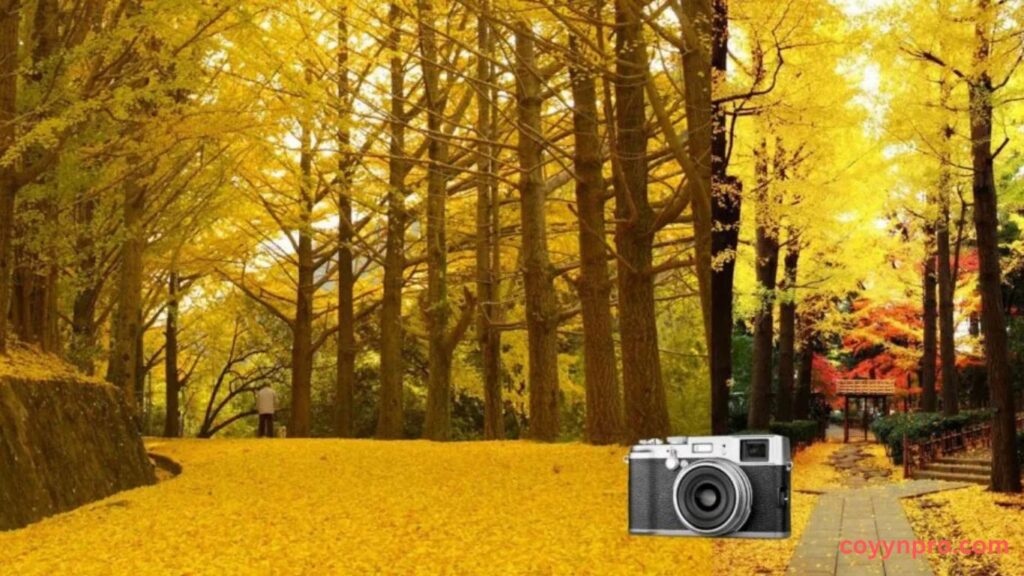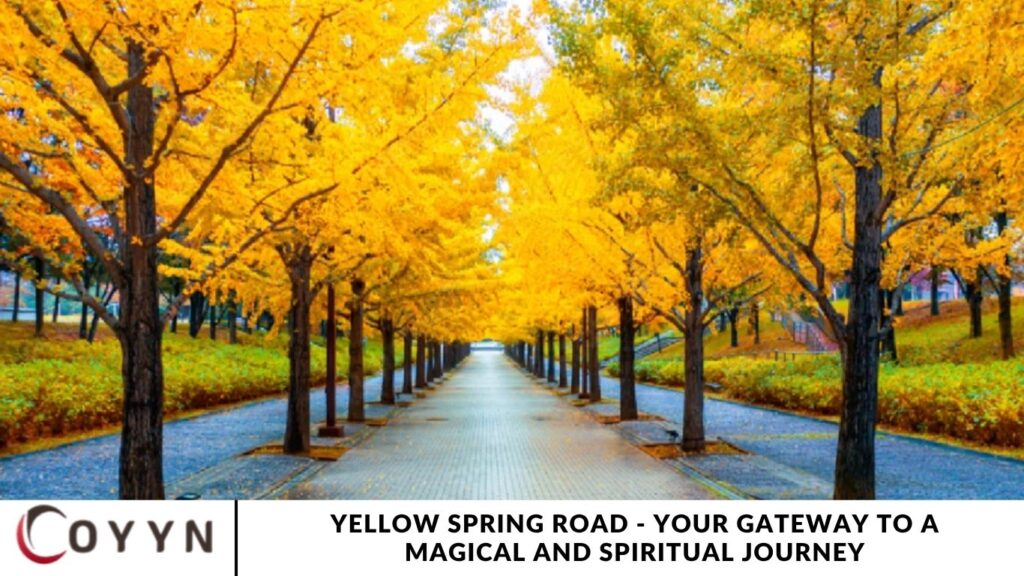One of the most serene and calming experiences anyone can enjoy is driving down a beautiful, quiet, And peaceful road. While such experiences can be found worldwide, Yellow Spring Road in Japan stands out as a legendary route celebrated for its breathtaking beauty and tranquil atmosphere. Nestled in Japan, a country renowned for its deep-rooted Zen culture, this road offers more than just a scenic drive.
Yellow Spring Road Japan is much more than a physical path—it’s a gateway into Japan’s rich history, ancient mythology, spiritual traditions, and mystical heritage. For centuries, this iconic road has been a sacred pilgrimage route, attracting not only devoted pilgrims but also modern-day travelers seeking peace and enlightenment.
Even if visiting Yellow Spring Road in person isn’t possible, we can still embark on a mental journey by exploring its fascinating history and cultural importance. Through learning and imagination, we can transport ourselves to this enchanting road and experience the profound sense of calm and spiritual connection that countless visitors have cherished over the ages.
What Makes It So Beautiful
Yellow Spring Road is unlike any other road—it’s not just about the destination but the feelings it awakens as you journey along it.
The path is lined with ancient trees, their leaves filtering sunlight into soft, dancing waves of light. Moss-covered stones mark the edges, creating a calm, tranquil atmosphere steeped in timeless charm.
Meanwhile, in Chiba, the landscape transforms beautifully from late February to April. Along the path, vibrant nanohana flowers bloom in bright yellow, filling the air with a fresh floral scent and the gentle hum of bees. Locals affectionately refer to this stretch as “the road of early spring,” celebrating its seasonal magic.
What truly sets Yellow Spring Road apart is its quiet elegance. It’s not flashy or loud—it’s a gentle, peaceful journey filled with natural beauty at every step.
Historical Significance of Yellow Spring Road
Situated in the sacred Kumano region of the Kii Peninsula within Wakayama Prefecture, Japan, the Yellow Spring Road is deeply connected to the ancient Shinto legend of Izanami and Izanagi, two pivotal deities in Japanese mythology. This connection makes the road a powerful spiritual symbol, believed to be a pathway to Yomi, the mythical land of the dead in Shinto belief.
The natural beauty of Yellow Spring Road perfectly complements its profound religious significance. For centuries, hundreds of thousands of pilgrims have traveled this route in search of spiritual enlightenment and connection. As a result, the road holds immense historical and cultural importance—especially for those who embrace Japan’s spiritual traditions.
A Spiritual Pilgrimage
Yellow Spring Road has attracted not only pilgrims but also tourists and casual visitors seeking a meaningful spiritual or religious experience. Even those who don’t identify as spiritual cannot deny the road’s breathtaking beauty and the deep emotions it evokes. In many ways, this profound sense of peace and connection is what defines the essence of spirituality associated with Yellow Spring Road.
Natural Beauty and Serene Landscapes
Describing the physical landscape of Yellow Spring Road instantly evokes a quintessentially Japanese atmosphere. While similar landscapes may exist elsewhere, the scene uniquely embodies Japan’s natural beauty. The dense forests, the winding path weaving through them, ancient trees casting shade on both sides and moss-covered stones lining the route—all these elements come together to create an unmistakably Japanese setting.
Yellow Spring Road is A Nature Lover’s Paradise
Another vital aspect that makes Yellow Spring Road truly special is its rich natural beauty, showcased through the diverse flora and fauna along its path. The wide variety of trees—especially those that turn vibrant yellow in the season—and the delicate wildflowers that fill the air with a unique, enchanting fragrance all combine to create an unforgettable experience that captivates every visitor.
Beyond its stunning flora, Yellow Spring Road is also home to a rich variety of fauna that enhances its natural charm. As you travel along the road, you can hear the melodious songs of birds, spot playful squirrels darting through the trees, and glimpse majestic deer roaming the forest. With a bit of luck, you might even catch sight of the elusive foxes that inhabit this enchanting region of Japan.
Preserving the Cultural Heritage
One of Japan’s greatest strengths lies in preserving its rich cultural heritage, and Yellow Spring Road is a shining example of this dedication. Due to its profound historical, religious, and spiritual importance, the road has been designated a UNESCO World Heritage Site and is celebrated as a national treasure of Japan.
Reed more: The World’s Darkest Skin Tone Explained with Research
Nearby Attractions
Beyond Yellow Spring Road, the Kumano Region offers a wealth of cultural and religious attractions that deepen your understanding of Japan’s spiritual heritage. When visiting this sacred area, be sure to explore these must-see destinations:
- Kumano Nachi Taisha: One of the three sacred Kumano Sanzan shrines, Kumano Nachi Taisha is renowned for the breathtaking Nachi Falls, the tallest waterfall in Japan. This shrine serves as a major pilgrimage destination, attracting countless visitors who seek spiritual connection and natural beauty.
- Kawayu Onsen, located near Yellow Spring Road, is a renowned natural hot spring renowned for its warm, healing waters. It’s an ideal spot for pilgrims and travelers to relax and rejuvenate after exploring the sacred Kumano trails.
- Kumano Hayatama Taisha: Situated at the mouth of the Kumano River, Kumano Hayatama Taisha is another revered shrine of the Kumano Sanzan. It is especially famous for its ancient camphor tree, believed to be over a thousand years old—a powerful symbol of longevity and strength.
- Kumano Hongu Taisha: As the spiritual core of the Kumano Kodo pilgrimage routes, Kumano Hongu Taisha offers a tranquil, forested setting perfect for prayer and reflection. This shrine embodies the serene essence of the Kumano spiritual journey.
Yellow Spring Road in Popular Culture
Given the stunning beauty of Yellow Spring Road, it’s no surprise that it holds a prominent place in Japanese pop culture. The road has been featured in various movies, TV shows, and literary works, where its spiritual and religious significance remains a central theme.

This cultural presence underscores the profound respect Japanese society holds for its history and traditions. The continued retelling of stories about Yellow Spring Road Japan across generations signals that the younger generation also cherishes and honors their cultural heritage.
Natural Wonders and Seasonal Beauty Along the Road
Yellow Spring Road Japan has transformed into one of the country’s most vibrant and colorful destinations. Renowned worldwide for its spectacular autumn foliage, Japan presents a breathtaking display of colors. The golden leaves of ginkgo biloba trees create a glowing tunnel beneath the crisp autumn sky, enchanting every visitor.
The area’s rich Japanese flora and fauna add to the magic—herons may be seen in nearby rice fields while playful squirrels dart through the tree branches. This harmonious blend of vivid colors, serene atmosphere, and abundant wildlife turns a simple stroll into an unforgettable experience. It’s undoubtedly one of the top fall season travel destinations in Japan.
| Season | Scenic Features |
|---|---|
| Spring | Cherry blossoms and soft pink skies |
| Summer | Lush green hills and peaceful rivers |
| Autumn | Gingko foliage, red maples, golden light |
| Winter | Snow-dusted temples and quiet walks |
Seasonal Festivals and Local Celebrations
The region surrounding Yellow Spring Road in Japan beautifully celebrates every season with its unique traditions and festivals. In the spring, the vibrant Aoi Matsuri Festival illuminates the area with colorful parades and sacred rituals. During fall, charming harvest fairs bring small-town warmth, offering visitors a chance to savor local cuisine and join lively dance circles.
Another highlight is the Jindaiji Daruma Doll Fair, where locals gather to buy, sell, and trade handmade good luck charms. These authentic Japanese cultural festivals not only preserve ancient traditions but also offer visitors from the U.S. and beyond a unique glimpse into Japan’s everyday life and spiritual celebrations.
Frequently Asked Questions
What is Yellow Spring Road, and why is it famous?
Yellow Spring Road is a scenic and spiritual pathway in Japan, renowned for its natural beauty, rich history, and deep connections to Japanese mythology and religion, making it a popular destination for pilgrims and travelers alike.
Where is Yellow Spring Road located?
Yellow Spring Road is located in the sacred Kumano region of the Kii Peninsula, within Wakayama Prefecture, Japan.
What spiritual significance does Yellow Spring Road hold?
The road is linked to the Shinto deities Izanami and Izanagi. It symbolizes a journey to Yomi, the land of the dead, making it a profound spiritual route in Japanese culture.
When is the best time to visit Yellow Spring Road?
Each season offers unique beauty—spring brings blooming flowers, autumn showcases vibrant foliage, while summer and winter provide tranquil, nature-filled experiences.
Can I visit Yellow Spring Road as a casual traveler, or is it only for pilgrims?
Both pilgrims and casual tourists visit Yellow Spring Road. While it holds deep religious significance, anyone can enjoy its serene landscapes and peaceful atmosphere.
What wildlife might I encounter on Yellow Spring Road?
Visitors may see a variety of wildlife, including birds, playful squirrels, majestic deer, and sometimes the elusive foxes native to the region.
Are there any nearby attractions to explore around Yellow Spring Road?
Yes! Nearby attractions include the three sacred Kumano Sanzan shrines—Kumano Nachi Taisha, Kumano Hayatama Taisha, and Kumano Hongu Taisha—as well as natural hot springs like Kawayu Onsen.
Conclusion
Yellow Spring Road is far more than just a scenic trail—it’s a sacred passage that connects the physical world with the spiritual essence of Japan. Nestled in the heart of the Kumano region, this iconic path invites both pilgrims and curious travelers to step into centuries of rich mythology, breathtaking natural beauty, and a profound cultural heritage.
Whether you’re drawn by the breathtaking beauty of moss-covered stones and blooming wildflowers, the deep spiritual resonance tied to Shinto beliefs, or simply the peace it offers with every step, Yellow Spring Road delivers a transformational experience like no other.


